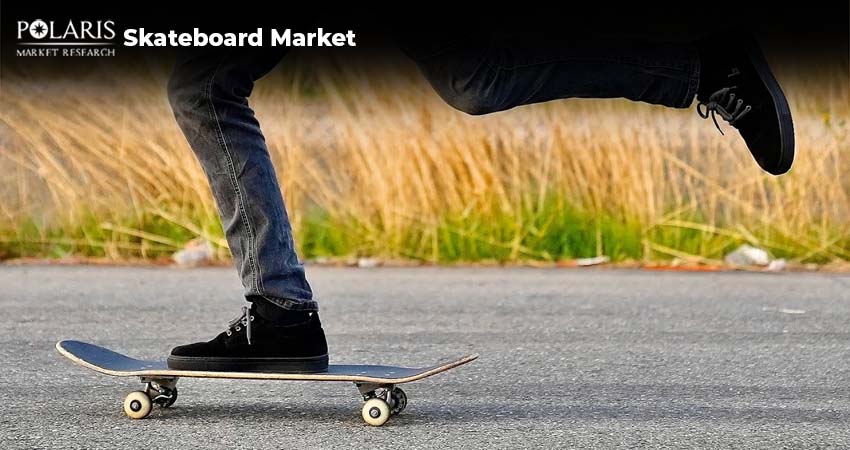Top 5 Companies in Skateboard Market to Know in 2025

Skateboarding is more than just a sport. It’s a lifestyle, a form of self-expression, and a global phenomenon that has transcended generations. Skateboarding has come a long way, from its humble beginnings in the 1950s to becoming a global cultural movement and an Olympic sport. Whether for street tricks, downhill racing, or casual cruising, skateboards have evolved in design, materials, and technology. Today, the industry is booming, with new trends like electric skateboards, sustainable materials, and innovative deck shapes shaping the market.
Today, the skateboard market is a thriving ecosystem of brands, manufacturers, and artisans who are pushing the boundaries of design, performance, and sustainability. In this blog, we’ll dive into the world of skateboards, exploring their history, components, and the top companies shaping the market.
Evolution of Skateboards
The story of skateboarding began in the 1950s when surfers in California sought a way to “surf” over land. The first skateboards were often homemade creations consisting of wooden planks attached to roller skate wheels. By the 1970s, skateboarding had gained mainstream popularity thanks to advancements like polyurethane wheels, which provided better grip and smoother rides. The 1980s and 1990s saw the rise of street skating and vert skating, with iconic brands like Powell Peralta and Santa Cruz leading the charge.
Fast forward to the 21st century, and skateboarding has become a global sport, with its debut at the 2020 Tokyo Olympics marking a new era of recognition and legitimacy. Today, skateboards are not just tools for recreation but also canvases for art, vehicles for activism, and symbols of counterculture.
Anatomy of Skateboards
A skateboard may seem simple, but it’s a carefully engineered piece of equipment. Here’s a breakdown of its key components.
- Deck
The deck is a flat board that you stay on, typically made from 7-9 layers of maple wood. Decks come in various shapes and sizes, catering to different styles of skating, such as street, vert, or cruising.
- Trucks
Mounted underneath the deck, they are metallic T-shaped components that connect the wheels to the deck and allow for turning.
- Wheels
Skateboard wheels are usually made of urethane and vary in size and hardness depending on the type of skating. Softer, larger wheels are a good choice for cruising, while smaller, harder wheels are ideal for street skating.
- Bearing
These small, circular components fit inside wheels and enable them to spin smoothly.
- Grip Tape
A sandpaper-like sheet applied to the top of the deck, grip tape provides traction for your feet.
- Hardware
It consists of nuts and bolts used to assemble the skateboard.
Trending Skateboards Design & Technologies
Custom & AI-Designed Skateboards
Skate companies now use artificial intelligence (AI) to analyze skateboarding data, creating decks optimized for tricks, durability, and balance. Custom board designs have also become more accessible with 3D printing technology.
Sustainable & Eco-Friendly Skateboards
With growing environmental awareness, companies are shifting to bamboo decks, recycled plastic wheels, and biodegradable grip tape to reduce waste and carbon footprints.
Electric Skateboards (E-Boards)
E-boards are one of the hottest trends, featuring powerful motors, regenerative braking, and smart connectivity for a seamless riding experience. Brands like Boosted and Meepo are leading this revolution.
High-Tech Skateboard Wheels & Bearings
Innovations like self-lubricating bearings, shock-absorbing wheels, and heat-resistant urethane compounds enhance performance and durability.
Major Companies in Skateboard Manufacturing
The skateboard market is home to a mix of legacy brands, innovative startups, and boutique manufacturers. Following are some of the most influential companies in the marketplace.
- Powell-Peralta
Founded in 1978, Powell-Peralta is one of the most iconic skateboard brands in history. Headquartered in Santa Barbara, California, USA, it is known for its Bones Brigade team, which included legends like Tony Hawk and Rodney Mullen. Powell-Peralta revolutionized skateboarding with its high-quality decks and wheels. Today, the brand continues to innovate while paying homage to its roots.
Santa Cruz is another pioneer in the skateboard industry, established in 1973. Famous for its bold graphics and collaborations with artists, Santa Cruz has remained a favorite among skaters for decades. The brand also emphasizes sustainability, using eco-friendly materials in its products. Its headquarters are based in Santa Cruz, California, USA.
- Element Skateboards
Element Skateboards has headquarters in Huntington Beach, California, and Saint-Jean-de-Luz, France. Element is a global leader in skateboarding, known for its commitment to environmental and social responsibility. Founded in 1992, the brand has become synonymous with progressive design and high-performance boards. Element’s “Give Back” program focuses on sustainability goals as it supports initiatives like reforestation and youth empowerment.
Plan B, founded in 1991 and headquartered in San Diego, California, USA, quickly gained a reputation for its elite team of riders and cutting-edge technology. After a brief hiatus, the brand made a triumphant return in 2005 and continues to produce some of the most sought-after decks in the industry.
- Baker Skateboards
Baker Skateboards' headquarters are located at Grosse Pointe, Michigan, USA. Baker Skateboards is a skateboard company that was founded in 2000 and is known for its high-quality skateboard decks, bold graphics, and support for its talented skateboarders. The brand has cultivated a loyal following through its authentic approach to skateboarding culture and its support of up-and-coming riders.
Why Skateboarding is More than Just a Sport?
Skateboarding is a unique blend of sport, art, and culture. It’s a platform for creativity, a tool for social change, and a way to connect with like-minded individuals. Whether you’re a seasoned pro or a beginner picking up a board for the first time, skateboarding offers something for everyone.
Conclusion
The skateboard market is more dynamic than ever, with constant innovations, rising demand for e-boards, and a push towards sustainability. The skateboard itself has evolved into a sophisticated piece of equipment, thanks to the efforts of pioneering brands and innovative manufacturers. Whether it’s pro skater, a commuter, or just getting started, there’s now a skateboard out there that fits specific needs.

